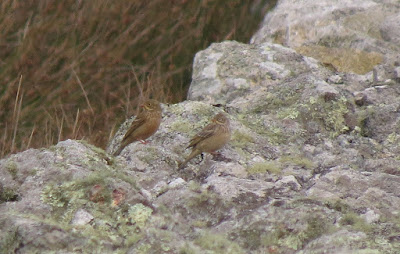 |
| © www.robwilsonphotos.co.uk |
I’m writing this just before the Winter Solstice, looking
out on yet another unseasonably mild but gloomy, wet and windy day here on the
North Devon coast. The weather has been stuck in this rut for virtually all of
November and December, doubtless making life on Lundy challenging for residents
and visitors alike – be they human or avian. There is always a lull in bird
news at this time of year, reflecting the end of autumn migration, dwindling
daylength and the greater difficulty of getting to the island during
‘helicopter season’. However, the relentlessly wild weather means that there
has been a particular dearth of news in recent weeks, with one of the main
items of interest (also weather-related) coming from thouands of kilometres
away... Details below.
It just remains to wish everyone a Merry Christmas and Happy
New Year; here’s hoping that 2016 is a good one for Lundy birds and
birdwatchers!
Tim Jones
Late-November Black-throated Diver
Philip Lymbery reported a Black-throated Diver off the East Side during the last week of November. Other notable sightings included a Mistle Thrush on 23rd and a ring-tail Hen Harrier on 26th.
Lundy Shearwaters fall victim to South Atlantic storms
Sadly, three of the Manx Shearwaters ringed as chicks on Lundy in early September this year were washed up dead on the Brazilian coast between 30th October and 9th November. These deaths appear to be linked to a period of exceptionally stormy weather off the coast of Brazil, which may have hit inexperienced young shearwaters – on their first migration to the South Atlantic winter quarters – disproportionately hard. There were reports from one Brazilian ornithologist of more than 200 shearwaters being washed up along just one section of coastline during a five-day period. Lundy Field Society members can read the full story in the next edition of the LFS Bulletin.
BTO NEWS survey
The third national Non-Estuarine Waterbirds Survey (NEWS), organised by the British Trust for Ornithology (BTO), is taking place between 1st December and 31st January. Chris Dee and Tim Davis will be covering the whole of Lundy’s shoreline during the last week of January. Thanks go to the BTO, LFS and Landmark Trust for assisting financially and logistically and to the North Devon NEWS Organiser, Brian O’Leary, for encouragement and support.
Tim Jones
Late-November Black-throated Diver
Philip Lymbery reported a Black-throated Diver off the East Side during the last week of November. Other notable sightings included a Mistle Thrush on 23rd and a ring-tail Hen Harrier on 26th.
Lundy Shearwaters fall victim to South Atlantic storms
Sadly, three of the Manx Shearwaters ringed as chicks on Lundy in early September this year were washed up dead on the Brazilian coast between 30th October and 9th November. These deaths appear to be linked to a period of exceptionally stormy weather off the coast of Brazil, which may have hit inexperienced young shearwaters – on their first migration to the South Atlantic winter quarters – disproportionately hard. There were reports from one Brazilian ornithologist of more than 200 shearwaters being washed up along just one section of coastline during a five-day period. Lundy Field Society members can read the full story in the next edition of the LFS Bulletin.
BTO NEWS survey
The third national Non-Estuarine Waterbirds Survey (NEWS), organised by the British Trust for Ornithology (BTO), is taking place between 1st December and 31st January. Chris Dee and Tim Davis will be covering the whole of Lundy’s shoreline during the last week of January. Thanks go to the BTO, LFS and Landmark Trust for assisting financially and logistically and to the North Devon NEWS Organiser, Brian O’Leary, for encouragement and support.




















































